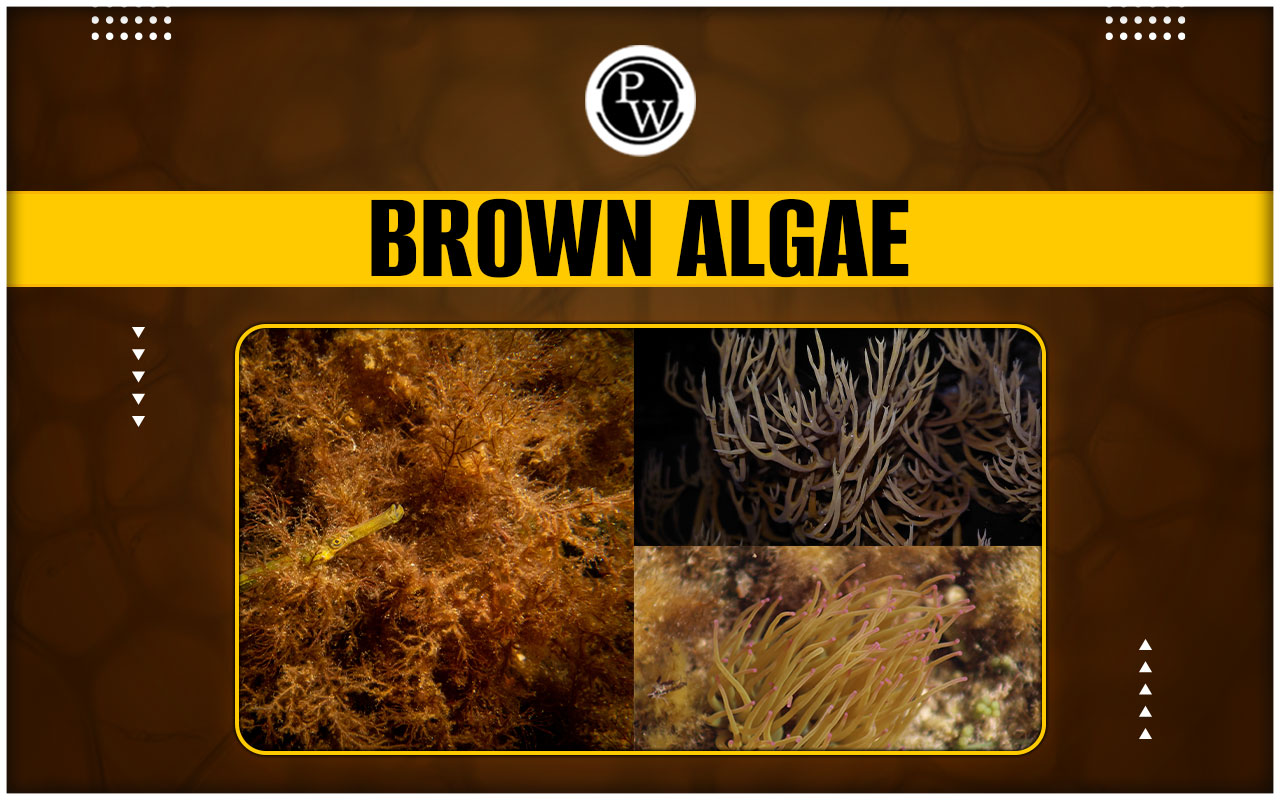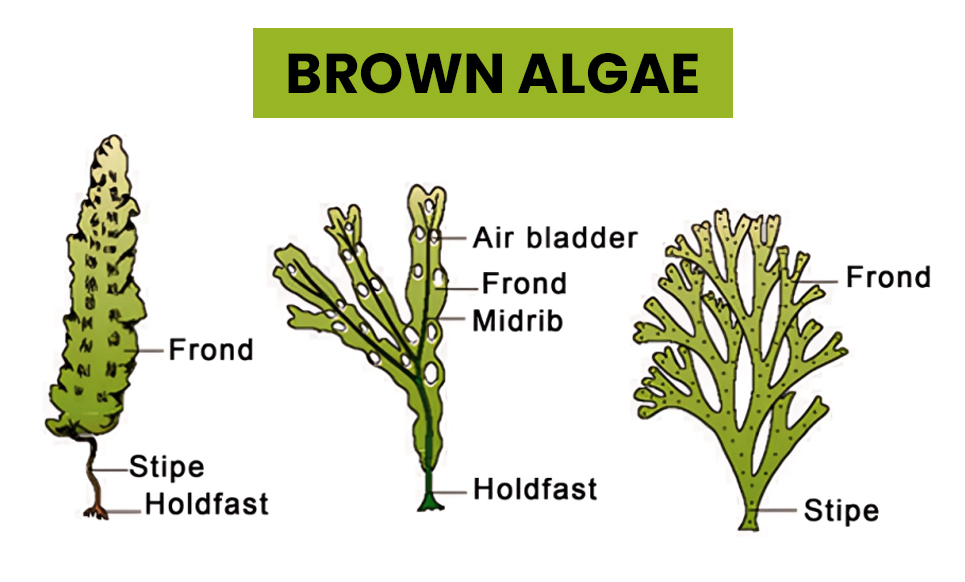

Brown algae are classified as Phaeophyceae and are known for their distinct colors, which range from brown to olive green. These algae predominantly inhabit marine environments. There are approximately 1,500 species of brown algae, showcasing a wide variety in size and shape. They are multicellular organisms, and their coloration is determined by the balance of chlorophyll and the pigment fucoxanthin. Brown algae include seaweeds such as Fucus, Ectocarpus, Sargassum, and giant kelps. NEET Biology Notes on Brown Algae are provided in the article below.
Brown Algae Classification
Brown algae, belonging to the class Phaeophyceae, are a diverse group of primarily marine organisms known for their brown pigment, fucoxanthin. They play a significant role in marine ecosystems, particularly in coastal environments. The classification of brown algae spans multiple taxonomic ranks, from domain to species. The table below provides a concise overview of this classification, including key examples of orders, families, genera, and species within the group.| Brown Algae Classification | |
|---|---|
| Taxonomic Rank | Classification |
| Domain | Eukaryota |
| Kingdom | Chromista |
| Phylum | Ochrophyta |
| Class | Phaeophyceae |
| Orders | Fucales, Laminariales, Dictyotales |
| Families | Fucaceae, Laminariaceae, Dictyotaceae |
| Genera | Fucus, Laminaria, Dictyota |
| Species | Fucus vesiculosus, Laminaria digitata, Dictyota dichotoma |
Sexual Reproduction in Flowering Plants

Brown Algae Structure
Brown algae, classified under the class Phaeophyceae, are a diverse group of multicellular algae predominantly found in marine environments, especially in the cooler waters of the Northern Hemisphere. This general structure can vary among different species of brown algae.- Size and Form: Brown algae exhibit a wide variety of sizes and shapes. The smallest types appear as tiny, feathery tufts of threadlike cells, only a few centimeters long. Some species have a life stage that consists of just a few cells, rendering them microscopic. Conversely, larger species, such as giant kelp, can grow up to 60 meters (200 feet) in length.
- Thallus: The body of brown algae is known as a thallus, which means they do not have true roots, stems, or leaves.
- Holdfast: Brown algae have a root-like structure called a holdfast, which anchors them to the substrate. Unlike roots in plants, the holdfast does not absorb nutrients or water but prevents the algae from being swept away by currents.
- Stipe: Some brown algae possess a stalk-like structure called a stipe, similar to a stem. In the most complex species, such as Fucus, the stipe consists of three distinct tissue layers: a central pith, a surrounding cortex, and an outer epidermis.
- Lamina: They feature a flattened structure known as the lamina, blade, or frond, which resembles leaves.
- Pneumatocysts: Certain brown algae contain gas-filled bladders called pneumatocysts. These bladders provide buoyancy, keeping parts of the algae near the surface to facilitate photosynthesis.
- Cell Wall: The cell wall of brown algae is composed of two layers: an outer gummy layer made of algin and an inner layer of cellulose, which provides structural strength.
- Pigments: Brown algae contain the pigment fucoxanthin, which gives them their characteristic greenish-brown color.
- Food Storage: They store food in the form of complex carbohydrates, such as laminarin or mannitol.
Brown Algae Characteristics
Brown algae play a crucial role in the marine ecosystem by providing food, habitat, and oxygen. Here are some important characteristics of brown algae:- Habitat: Brown algae predominantly inhabit marine environments, especially in cold coastal waters. They may be free-floating or attached to the seabed.
- Size and Shape: They exhibit a wide range of sizes and shapes, from small species a few centimeters long to giant kelps that can grow up to 100 meters.
- Structure: These algae are multicellular and lack true roots, stems, and leaves. Instead, they have holdfasts (which anchor them), stipes (stalk-like structures), and blades or fronds (leaf-like structures). Some species possess gas bladders that aid in flotation.
- Cell Wall: Their cell walls are two-layered, consisting of an outer layer containing a gummy substance called algin and an inner layer made of cellulose, which provides strength.
- Pigments: Brown algae contain chlorophyll a and c, along with carotenoids and xanthophylls, including fucoxanthin, which gives them their characteristic brown color.
- Reproduction: They undergo alternation of generations, featuring both sexual and asexual stages in their life cycle.
Structural Organisation in Animals
Brown Algae Examples
Brown algae, scientifically known as Phaeophyceae, derive their name from their distinctive color, ranging from brown to olive green. There are approximately 1,500 brown algae species, mostly found in marine environments. Here are a few notable examples:- Ectocarpus: An epiphytic brown algae.
- Fucus: Typically found attached to rocks.
- Sargassum: Known for being free-floating.
- Kelp: Part of the order Laminariales, capable of growing up to 100 meters long.
- Macrocystis: A type of giant kelp that forms extensive underwater forests.
- Nereocystis: Another variety of giant kelp.
- Ascophyllum: A well-known species of brown algae.
- Durvillaea Antarctica: A specific type of brown algae.
- Dictyotales: A classification within brown algae.
- Chordariales: Another classification within this group.
Brown Algae Reproduction
Brown algae, a diverse group of large, multicellular algae, reproduce through both asexual and sexual means. Asexual Reproduction:- Brown algae can reproduce asexually by producing zoospores or aplanospores.
- Zoospores are generated within both unicellular (unilocular) and multicellular (plurilocular) sporangia and are always found on the diploid thallus (sporophyte).
- Vegetative reproduction occurs through fragmentation.
- The motile zoospores are pear-shaped and have two unequal flagella.
| Important NEET Biology Notes | ||
|---|---|---|
| Selaginella | Embryo | Malvaceae |
| Pinus | Polyembryony | Volvox |
- Brown algae reproduce sexually using flagellated spores and gametes.
- These spores and gametes closely resemble the cells of single-celled Stramenopiles.
- Brown algae undergo two distinct stages: initially, they exist as spores released from the parent plant, which develop into male or female plants producing sperm or eggs. These gametes then fertilize to form the mature plant in the second stage.
Brown Algae Economic Importance
Brown algae are found primarily in cooler coastal waters and have a variety of structures and sizes. Brown algae, scientifically known as Phaeophyceae, hold significant economic value for several reasons:- Food and Feed: Certain brown algae such as Sargassum, Laminaria, and Fucus are used as feed for livestock and poultry. Algin, a crystalline substance derived from the outer cell walls of large brown algae like kelps, is widely employed in food products.
- Fertilizers: Brown algae contribute to fertilizer production, with species like Macrocystis providing Potash, a crucial element that enhances soil fertility for agriculture.
- Cosmetics: The cosmetic industry benefits from the properties of brown algae, using them in various products.
- Pharmaceuticals: Brown algae species like Ascophyllum are utilized in antibiotic production, while Laminaria is used in medicines for goitre treatment. Algin serves as a gelling agent in pharmaceutical applications.
- Industrial Applications: Algin is extensively used in industries such as textiles.
- Ecological Importance : Brown algae form expansive underwater forests known as kelp forests, which support diverse marine life.
| Important NEET Biology Notes | ||
|---|---|---|
| Chara | Funaria | Apomixis |
| Rhizopus | Spirogyra | Bacteriophage |
| NEET Exam Important Links | |
|---|---|
| NEET Biology Syllabus | NEET Biology Diagrams |
| NEET Biology MCQ | NEET Biology Chapter wise Weightage |
| NEET Biology Notes | NEET Previous Year Question papers |
Brown Algae FAQs
Q 1. What is brown algae?
Ans. Brown algae, or Phaeophyceae, are large seaweeds with a brown color due to the pigment fucoxanthin and sometimes phaeophycean tannins.
Q 2. Why are brown algae brown?
Ans. Brown algae are brown because of the pigment fucoxanthin, which masks chlorophyll a and c, beta-carotene, and other pigments. They store energy as complex sugars and alcohols.
Q 3. Are brown algae helpful or harmful?
Ans. Brown algae, like Sargassum, are beneficial, providing habitat and food for marine life without harmful effects like red tides.
Q 4. What do brown algae eat?
Ans. Brown algae, such as diatoms, thrive on high nitrates and benefit from regular aquarium changes.
Q 5. What are two uses of brown algae?
Ans. Brown algae are used for algin production as a stabilizer in baking and ice cream, and some species are consumed as vegetables in East Asia.
Talk to a counsellorHave doubts? Our support team will be happy to assist you!

Check out these Related Articles
Free Learning Resources
PW Books
Notes (Class 10-12)
PW Study Materials
Notes (Class 6-9)
Ncert Solutions
Govt Exams
Class 6th to 12th Online Courses
Govt Job Exams Courses
UPSC Coaching
Defence Exam Coaching
Gate Exam Coaching
Other Exams
Know about Physics Wallah
Physics Wallah is an Indian edtech platform that provides accessible & comprehensive learning experiences to students from Class 6th to postgraduate level. We also provide extensive NCERT solutions, sample paper, NEET, JEE Mains, BITSAT previous year papers & more such resources to students. Physics Wallah also caters to over 3.5 million registered students and over 78 lakh+ Youtube subscribers with 4.8 rating on its app.
We Stand Out because
We provide students with intensive courses with India’s qualified & experienced faculties & mentors. PW strives to make the learning experience comprehensive and accessible for students of all sections of society. We believe in empowering every single student who couldn't dream of a good career in engineering and medical field earlier.
Our Key Focus Areas
Physics Wallah's main focus is to make the learning experience as economical as possible for all students. With our affordable courses like Lakshya, Udaan and Arjuna and many others, we have been able to provide a platform for lakhs of aspirants. From providing Chemistry, Maths, Physics formula to giving e-books of eminent authors like RD Sharma, RS Aggarwal and Lakhmir Singh, PW focuses on every single student's need for preparation.
What Makes Us Different
Physics Wallah strives to develop a comprehensive pedagogical structure for students, where they get a state-of-the-art learning experience with study material and resources. Apart from catering students preparing for JEE Mains and NEET, PW also provides study material for each state board like Uttar Pradesh, Bihar, and others
Copyright © 2025 Physicswallah Limited All rights reserved.
Get App











